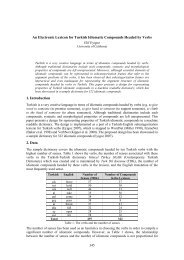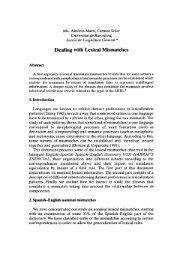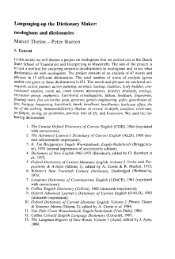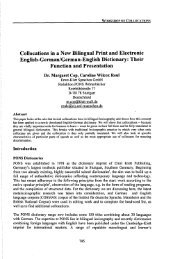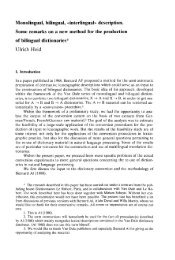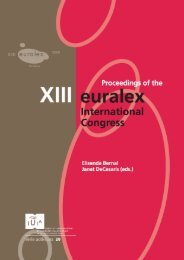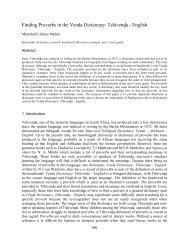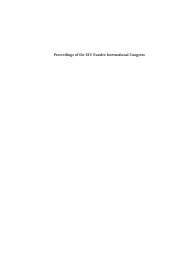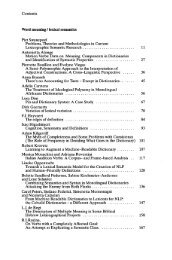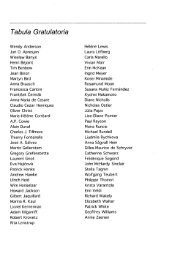Creating a phraseme matrix based on a Tertium ... - Euralex
Creating a phraseme matrix based on a Tertium ... - Euralex
Creating a phraseme matrix based on a Tertium ... - Euralex
Create successful ePaper yourself
Turn your PDF publications into a flip-book with our unique Google optimized e-Paper software.
2. Resources<br />
For the SNSF funded project “German Proverbs and idioms in language change. Onlinedicti<strong>on</strong>ary<br />
for diachr<strong>on</strong>ic phraseology” (OLdPhras), we had to decide which <str<strong>on</strong>g>phraseme</str<strong>on</strong>g>s to<br />
investigate in detail. It is not possible to provide a high-quality, dense diachr<strong>on</strong>ic dicti<strong>on</strong>ary<br />
including every <str<strong>on</strong>g>phraseme</str<strong>on</strong>g> found in a large text corpus or included in at least <strong>on</strong>e of the<br />
dicti<strong>on</strong>aries menti<strong>on</strong>ed in secti<strong>on</strong> 1 (see Mahlow and Juska-Bacher (2011) and Juska-Bacher<br />
and Mahlow (in print) for details). A first idea was to get an overview of which <str<strong>on</strong>g>phraseme</str<strong>on</strong>g>s (or<br />
variants) are menti<strong>on</strong>ed in at least two or three dicti<strong>on</strong>aries. <str<strong>on</strong>g>Creating</str<strong>on</strong>g> this kind of index<br />
manually was impossible. However, since the keywords of a dicti<strong>on</strong>ary can be extracted<br />
easily, we could gather the indices of the phraseological collecti<strong>on</strong>s automatically.<br />
Generic dicti<strong>on</strong>aries like Küpper (1997) or Grimm and Grimm (1852–1971) menti<strong>on</strong><br />
<str<strong>on</strong>g>phraseme</str<strong>on</strong>g>s within dicti<strong>on</strong>ary entries; the keywords are single words, and therefore not of<br />
interest for our purpose. However, some authors use distinct typographical features to mark<br />
<str<strong>on</strong>g>phraseme</str<strong>on</strong>g>s, thus allowing for automatic extracti<strong>on</strong> as well. Others like Adelung (1793–1801)<br />
use specific abbreviati<strong>on</strong>s in paragraphs menti<strong>on</strong>ing <str<strong>on</strong>g>phraseme</str<strong>on</strong>g>s. We used these to identify<br />
potentially interesting sentences and then marked <str<strong>on</strong>g>phraseme</str<strong>on</strong>g>s and variants manually. From this<br />
annotati<strong>on</strong> we could then extract all <str<strong>on</strong>g>phraseme</str<strong>on</strong>g>s automatically.<br />
We c<strong>on</strong>sidered two c<strong>on</strong>temporary and two historic collecti<strong>on</strong>s: Duden11 and RA-I, and<br />
Adelung and DSL—all in the digitized versi<strong>on</strong>. From these we extracted:<br />
3’974 manually annotated <str<strong>on</strong>g>phraseme</str<strong>on</strong>g>s and variants from Adelung,<br />
45’729 potential <str<strong>on</strong>g>phraseme</str<strong>on</strong>g>s from DSL (using the explicit marker of the author),<br />
13’287 <str<strong>on</strong>g>phraseme</str<strong>on</strong>g>s from Duden11 (using the typographical markup of <str<strong>on</strong>g>phraseme</str<strong>on</strong>g>s), and<br />
11’542 <str<strong>on</strong>g>phraseme</str<strong>on</strong>g>s from RA-I (using the provided index and removing duplicates)<br />
Given that the resources were created by different scholars at different points in time,<br />
following different phraseological schools or theories, printed by different publishers,<br />
following different lexicographic and editing guide lines, we assumed to find a <str<strong>on</strong>g>phraseme</str<strong>on</strong>g> to<br />
appear in different dicti<strong>on</strong>aries in various forms, in line with the results of the in-depth study<br />
by Stantcheva (2003). Expected and observed variati<strong>on</strong> includes: (a) spelling due to different<br />
language stages like in example 1; (b) word order (examples 2 or 3); (c) variati<strong>on</strong> in words<br />
used resulting in some kind of “similarity” (example 4); (d) a somewhat artificial<br />
formulati<strong>on</strong>—for example, using always the infinite verb form—or using a prototypical<br />
example with inflected word forms; (e) handling of valencies, for example, whether a valency<br />
can be filled by various nouns, pr<strong>on</strong>ouns, noun phrases, verbs, etc. (example 5); are valencies<br />
filled with a prototypical example or marked with an explicit place holder like etwas<br />
(‘something’) or sich (reflexive pers<strong>on</strong>al pr<strong>on</strong>oun), place holders can be written as<br />
abbreviati<strong>on</strong>, too; (f) providing morphosyntactic informati<strong>on</strong> <strong>on</strong> valency fillers, for example,<br />
explicit menti<strong>on</strong>ing of expected case like “+ Dat.” or using a marker in the placeholder like<br />
jemandem (the use of the Dativ case has to be deduced by the user); (g) inclusi<strong>on</strong> of possible<br />
modificati<strong>on</strong>s like using modal verbs, adverbs, or negati<strong>on</strong>.<br />
(1) (a) Alle Hände voll zu thun haben (Adelung)<br />
(b) alle/beide Hände voll zu tun haben (Duden11)<br />
‘to have both hands buisy (to have <strong>on</strong>e’s hands full)’ 4<br />
(2) (a) Augen haben wie ein Luchs (Duden11)<br />
(b) Augen wie ein Luchs haben (RA-I)<br />
‘to have eyes like a lynx (to have eagle-eyes)’<br />
721



